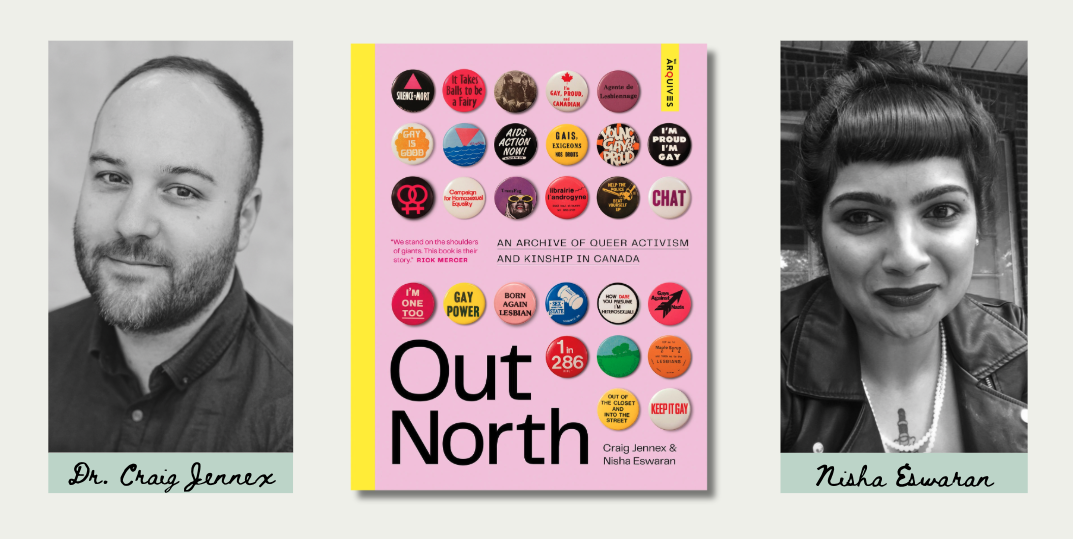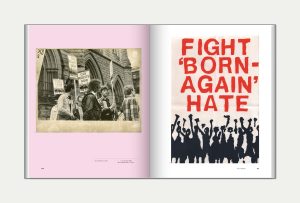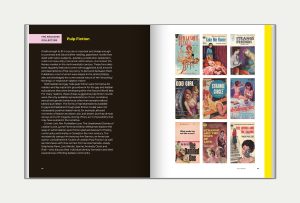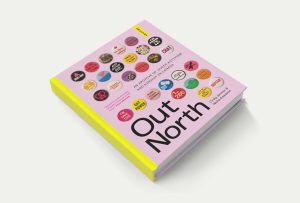June 14, 2023
Author Q&A: Out North
In honour of Pride Month, co-authors Dr. Craig Jennex and Dr. Nisha Eswaran joined Figure 1 to reflect on the process of writing Out North: An Archive of Queer Activism and Kinship in Canada and how the book has been received, three years after it was published.

Figure 1: How would you describe the process of writing Out North?
Dr. Craig Jennex: This was a huge project, mainly because the collection at The ArQuives: Canada’s LGBTQ2+ Archives, is so vast. We had to decide what stories and materials to present and think about the broader narrative of LGBTQ2+ activism and politics in Canada. And while the book covers a lot, it barely scratches the surface of The ArQuives’ collection and the stories of LGBTQ2+ lives in this country. All things considered, I think we were quite lucky: we got to spend years digging through historical materials, learning from queer and trans elders, and thinking about compelling ways to share these stories.
Dr. Nisha Eswaran: The process was very layered! There was a lot of material so we spent time thinking about how we wanted to organize and make sense of it. In the end, we focused on the forms of friendship, kinship, and often unexpected connection we saw between people and activist groups documented in this material. This helped us bring out some of what we thought were compelling but less widely known parts of the archive.
F1: Do you see the project differently now that the book has been out in the world for three years?
CJ: The longer the book is out in the world, the more proud I am of the work we did. It isn’t perfect—no book is—but it is the result of an incredible amount of hard work and collective support.
NE: In the last few years, more books have come out that seek to understand and recover the political and social possibilities of early/mid-20th century queer life. I think Out North has a lot in common with these books, and it would be very interesting to think more about why many queer writers are looking to the past as a source of political and creative guidance. If we were writing Out North now, we could engage further with this question, and that would be very exciting!

F1: Were there any unexpected challenges (or triumphs) along the way?
CJ: One of the most beautiful triumphs of the book writing process was how generous people were with their time and materials. We emailed hundreds of people to ask for permission to reproduce their work in the book and nearly everyone was quick to get back to us with their blessing without hesitation. It truly was a collective project made possible by the labour of so many people.
NE: It was an interesting challenge to figure out how to celebrate the gains of the queer social movements Out North documents while also making room for the losses of these movements. For instance, many of these people and groups sought a world not only without homophobia but also without racism, state violence, borders, and patriarchy. As these are very much ongoing struggles, we tried to think through what these social movements did—and what we can learn from them now—without romanticizing them.
F1: What kind of feedback have you received from readers?
CJ: It’s used as a textbook in university courses across Canada, it’s been taken up in book clubs, and the first printing sold out quite quickly. These reactions have been great, especially since the book was launched in the first few months of the pandemic, and I’m glad it’s still being embraced by readers.
NE: People are happy to see archival material that is moving, illuminating, and sometimes unexpected and, like me, are excited to feel connected to queer people who came before.

F1: Is there a photo or story that has stuck with you most?
CJ:I don’t think I can choose one! But the materials produced by the AIDS Committee of Toronto, AIDS ACTION NOW!, and the Black Coalition for AIDS Prevention have really stuck with me. During the early decades of the AIDS epidemic, regular citizens worked together to produce educational materials, lobby governments, and build political coalitions across difference. These activists saved lives and changed the world; we owe them so much.
NE: The story of the Van Dykes has stuck with me—I loved reading about their excitement, struggles, and hope for adventurous queer lives!
F1: What do you hope readers take away from Out North?
CJ: First, that these are complex and difficult histories. Second, that ordinary people have the capacity to radically reshape the world in which we live. Third, that The ArQuives is an incredible institution. And, finally, that queer and trans histories in this country are incredible stories of anger, care, creativity, and collective agency. These histories should provide us with guidance as we push back against contemporary examples of homophobia and transphobia.
NE: I hope Out North can contribute to people’s sense that in social movements against state oppression and injustice, there is the possibility for solidarity, kinship, and friendship across differences.

Find Out North in an independent bookstore near you, online through Amazon or Indigo, or directly from Figure 1. A new French language ebook Au nord: À nu is also available on Apple Books and Amazon.